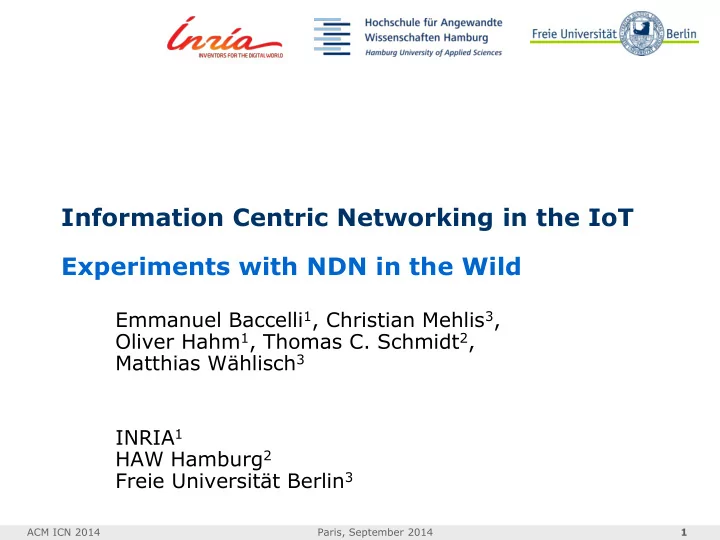

Information Centric Networking in the IoT Experiments with NDN in the Wild Emmanuel Baccelli 1 , Christian Mehlis 3 , Oliver Hahm 1 , Thomas C. Schmidt 2 , Matthias Wählisch 3 INRIA 1 HAW Hamburg 2 Freie Universität Berlin 3 ACM ICN 2014 Paris, September 2014 1
The Beauty of ICN in the IoT • Simplified, natural API • Example: Get “/ paris/cordeliers/ amphi_farabeuf /temperature” • Increased robustness by caching • Lossy wireless links in the IoT • Ease data fusion by hop-wise replication • Reduced network layer • Inherent auto-configuration • IoT devices w/o user interface ACM ICN 2014 Paris, September 2014 2
The Ugly of ICN in the IoT Additional states • Constrained devices are prevalent in the IoT Long names • IoT link layer technologies usually support short MTUs Do the benefits outweigh the challenges of ICN in the IoT? ACM ICN 2014 Paris, September 2014 3
What is this Talk About? • Explore basic feasibility and tradeoffs of ICN in the IoT • Report about experiments in real world testbed • Propose interoperable ICN enhancements for the IoT ACM ICN 2014 Paris, September 2014 4
Agenda IoT Model A Priori Challenges Enable ICN in the IoT Experiments Summary ACM ICN 2014 Paris, September 2014 5
IoT Model in this Talk Constrained devices • Power consumption in mWatt compared to Watt • Computations in megaFLOPS compared to GigaFLOPS • Memory in Kilobytes compared to Gigabytes Multi-hop wireless communication • MTUs between 30 bytes and 40 bytes Standardized interconnection • Connect with Internet-devices We look on the very low end IoT devices in the global (future) Internet! ACM ICN 2014 Paris, September 2014 6
Challenge: Limited Memory Implications on caching capabilities • Small-sized content doable • Example: Temperature value 12 bytes => 85 sensor values • Medium-sized content requires distributed chunk caching Implications on overlay applicability • ICN should work directly on link-layer Implications on routing approaches • Constant routing states preferred • Minimal control traffic ACM ICN 2014 Paris, September 2014 7
Implementing ICN in the IoT: Network Stack Which ICN implementation? • NDN (before the CCN/NDN split ;) Which operating system for IoT? • RIOT Porting CCN-Lite to RIOT • 1,000 lines of C code • Required ROM 16 kBytes • Required RAM 5 kBytes ACM ICN 2014 Paris, September 2014 8
Basic Routing with Vanilla Interest Flooding (VIF) Idea • Flood all content interests Advantages • Does not rely on additional control traffic • Requires no additional states Disadvantages • Does not scale with many nodes • Network transmissions are costly in terms of energy ACM ICN 2014 Paris, September 2014 9
Optimized Routing with Reactive Optimistic Name-based Routing (RONR) Idea • Assumption: Whole piece of content is stored on a node • Flood only the first interest for a content name • Subsequent interests for chunks are unicast Advantages • Reduces the number of radio transmissions, saves energy • Still, no control traffic and minimal states Disadvantage • Content delivery can be delayed ACM ICN 2014 Paris, September 2014 10
Experimental Setup • Deployment of ICN/IoT implementation in the FU testbed • 60 nodes distributed in several rooms and floors • Each node with CC1100 radio chip, CPU 868 MHz • Maximum link layer frame size 64 bytes • Basic configuration of the experiments • Size of name length 12 bytes • Consider single and multi consumer scenarios • Consider ICN with and without caching • Chunk size set to 58 bytes • Content size aligned to prevent fragmentation ACM ICN 2014 Paris, September 2014 11
Results - Single Consumer Scenario Vanilla Interest Flooding Reactive Opportunistic Forwarding • • It worked! 50% less radio transmissions compared to Vanilla flooding • Relatively large interest • signaling overhead In particular, less broadcasts ACM ICN 2014 Paris, September 2014 12
Results - Multi Consumer Scenario for RONR Without Caching With Caching • • Scales almost linearly with the Cache accommodates 20 chunks number of consumers • 2% of 96 kBytes of RAM • 50% less radio transmissions • Unicast benefits from caching ACM ICN 2014 Paris, September 2014 13
Comparison with Common IoT Protocols • Common IETF protocol suite for IoT: 6LoWPAN + RPL • Comparing required memory for protocol stack Module ROM RAM RPL + 6LoWPAN ~52 kBytes ~27 kBytes CCN-Lite ~16 kBytes ~5 kBytes ICN requires 70% less ROM, and 80% less RAM We now perform the same multi-consumer experiment with caching. ACM ICN 2014 Paris, September 2014 14
RONR Compared with 6LoWPAN/RPL Stack ACM ICN 2014 Paris, September 2014 15
Summary & Outlook We started from very basic scenarios and simple mechanisms • ICN is applicable in the Internet of Things • NDN/CCN implementation available with low memory footprint • Caching and opportunistic forwarding help to reduce packet loss and energy consumption • ICN may outperform current IoT protocols In the future • Deal better with typically small frame sizes • Header compression and fragmentation layer below NDN • IoT-specific content replication and cache replacement • Additional communication models • Short naming schemes optimized for constrained devices ACM ICN 2014 Paris, September 2014 16
Let’s Rock IoT with ICN! • Over 2,700 wireless sensor • Download, extend, and nodes across six sites experiment • RIOT and thus ICN runs in • http://github.com/RIOT- IoT-LAB OS/RIOT • Open for external researchers • http://www.riot-os.org ACM ICN 2014 Paris, September 2014 17
Recommend
More recommend